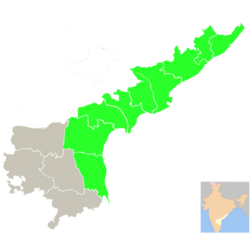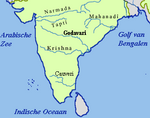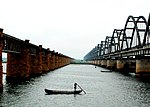Coastal Andhra
Coastal Andhra
Kōstā Āndhra | |
|---|---|
 Coastal Andhra region (old districts) highlighted in Andhra Pradesh | |
| Country | |
| State | |
| Districts |
|
| Largest city | |
| Major Cities | |
| Area | |
• Total | 91,915 km2 (35,489 sq mi) |
| Population (2011)[2] | |
• Total | 34,195,655 |
| Languages | |
| • Official | Telugu |
| Time zone | UTC+05:30 (IST) |
| Vehicle registration | AP05, AP06, AP07, AP08, AP16, AP18, AP26, AP27, AP37, AP39 |
| Largest airport | Visakhapatnam Airport |
Coastal Andhra, also known as Kosta Andhra (IAST: Kōstā Āndhra), is a geographic region in the Indian state of Andhra Pradesh, comprising the coastal districts of the state between the Eastern Ghats and the Bay of Bengal, from the northern border with Orissa to Rayalaseema in the south.[3] It includes major cities such as Visakhapatnam and Vijayawada as well as the state capital Amaravati and is recognized for its fertile lands, rich cultural heritage, and economic importance. Coastal Andhra plays a significant role in the state's agricultural output, particularly in rice and tobacco production, supported by abundant water resources from the Godavari, Krishna, and Penna rivers.[4][5]
While Coastal Andhra generally includes the districts along the Bay of Bengal, the Uttarandhra (Northern Andhra) area is sometimes regarded as distinct due to its unique cultural and historical background. Coastal Andhra shares borders with the Rayalaseema region of Andhra Pradesh and the state of Telangana. Covering an area of 91,915 square kilometres (35,489 sq mi), Coastal Andhra accounts for 58% of Andhra Pradesh's total area and, as per the 2011 Census of India, hosts a population of over 3.4 crore, constituting 69.20% of the state’s population. Coastal Andhra was formerly part of the Madras State until 1953 and then became part of Andhra State from 1953 to 1956.[3]
Historically, Coastal Andhra has been a centre of trade and culture, featuring strong traditions in literature, music, and dance. The region contributed actively to the Indian independence movement and continues to impact the state’s economy through industries such as information technology, petroleum, and pharmaceuticals. It is also home to major ports in Visakhapatnam and Kakinada, enhancing its status as a critical industrial and trading hub. Proximity to the Bay of Bengal, however, makes the region susceptible to tropical cyclones and coastal erosion, prompting investments in disaster preparedness and coastal management initiatives.[3]
History
[edit]The region of Andhra emerged as a prominent political power during the Maurya Empire. Historical accounts by Greek ambassador Megasthenes (c. 310 BCE) reference Andhra as a flourishing region under the Satavahanas before the Common Era.[6][7] The Satavahana dynasty dominated the Deccan Plateau from the 1st century BCE to the 3rd century CE.[8] It had trade relations with the Roman Empire.[9] The Satavahanas made Dhanyakataka-Amaravathi their capital. According to historian Stanley Wolpert, it might have been the most prosperous city in India in 2nd century CE.[10][11]
Coastal Andhra was subsequently governed by the Eastern Chalukya dynasty between the 7th and 12th centuries CE, followed by successive rule under the Chola, Kakatiya, and Vijayanagara empires.[12][13][14] According to 11th-century inscriptions, the geographical boundaries of Coastal Andhra extended from the Mahendragiri mountains in the northeastern border near Orissa’s Gajapati district, to the Kalahasti Temple in Tirupati district, and the Srisailam Temple in Nandyal district.[15]
In the mid-18th century, the Gajapati and Ganjam districts, which were part of Coastal Andhra, were granted to the French East India Company in 1752 but were later transferred to British control. Nellore, including areas reaching up to Ongole Taluk, came under British administration after being acquired from the Nawab of Arcot. Additionally, certain parts of present-day Nellore and Chittoor were managed by the Venkatagiri Rajas until 1802, when the British entered into an arrangement with the Raja of Venkatagiri, consolidating their control over these territories.[16]
The Andhra districts, historically known as the Northern Circars, along with the Rayalaseema region, were ceded by the Nizam of Hyderabad to the British colonial administration, becoming part of the Madras Presidency under British rule.[17]
Geography
[edit]Coastal Andhra is situated in the eastern region of the Indian state of Andhra Pradesh, along the Circar Coast. It covers an area of 91,915 square kilometres (35,489 sq mi).[3] It comprises 18 districts: Srikakulam, Vizianagaram, Parvathipuram Manyam, Alluri Sitarama Raju, Visakhapatnam, Anakapalli, Kakinada, Konaseema, East Godavari, West Godavari, Eluru, Krishna, NTR, Guntur, Palnadu, Bapatla, Prakasam, and Nellore.
The region borders the Rayalaseema region within Andhra Pradesh and shares boundaries with the state of Telangana. Fertile lands in Coastal Andhra are supported by the presence of three major rivers: the Godavari, Krishna, and Penna, which enhance agricultural productivity through extensive irrigation systems.[18]
The coastal length of this region spans approximately 974 km, making it the second-longest coastline in India.[18]
Demographics
[edit]According to the 2011 Census of India, Coastal Andhra has a total population of 34,195,655 constituting 69.20% of the state’s population.[3]
The majority of the population in Coastal Andhra practices Hinduism, accounting for approximately 93% of the residents. The Christian community represents around 1.51% of the region's population.[19]
The primary language spoken across Coastal Andhra is Telugu.[20]
Culture
[edit]Kuchipudi is the classical dance form of the state, which was originated in the Kuchipudi village of Krishna district.[21]
Cuisine
[edit]Rice is the staple food in the coastal cuisine and is usually consumed with a variety of curries and lentil soups or broths. The cuisine of Coastal Andhra is influenced by various seafood varieties.[22]
Politics
[edit]The Coastal Andhra region of Andhra Pradesh comprises 18 districts: Srikakulam, Vizianagaram, Parvathipuram Manyam, Alluri Sitharama Raju, Visakhapatnam, Anakapalli, Kakinada, Konaseema, East Godavari, West Godavari, Eluru, Krishna, NTR, Guntur, Palnadu, Bapatla, Prakasam and Nellore.[23]
Many Chief Ministers from the region have held office in Andhra Pradesh and Andhra State. They are:
- Tanguturi Prakasam Panthulu – 1st Chief Minister of Andhra State (Prakasam)
- Bezawada Gopala Reddy – 2nd Chief Minister of Andhra State (Nellore)
- Kasu Brahmananda Reddy – 5rd Chief Minister of Andhra Pradesh (Palnadu)
- Bhavanam Venkatarami Reddy – 10th Chief Minister of Andhra Pradesh (Guntur)
- N. T. Rama Rao – 12th Chief Minister of Andhra Pradesh (Krishna)
- Nadendla Bhaskara Rao – 13th Chief Minister of Andhra Pradesh (Guntur)
- K. Rosaiah – 17th Chief Minister of Andhra Pradesh (Bapatla)
Cities and towns
[edit]Visakhapatnam, Vijayawada, Guntur, Nellore, Kakinada, Rajahmundry and Eluru are prominent cities in the Coastal Andhra region. Other major urban centers include Gudivada, Tenali, Narasaraopeta, Bhimavaram, Machilipatnam, Ongole, and Tadepalligudem. Important towns in the area include Chirala, Amalapuram, Palakollu, Narasapuram, Kavali, Chilakaluripet, and Kandukur.
Visakhapatnam is the most populous city in the region, while Amaravati, serving as the state capital, is also situated within Coastal Andhra.
Tourism
[edit]Buddhist hub
[edit]
Coastal Andhra is a prominent hub for Buddhist heritage in India, second only to the Gangetic plains of Bihar and Uttar Pradesh. The region holds numerous ancient Buddhist sites, featuring remnants of large monasteries, stupas, and other significant artifacts that span from Srikakulam district in the north to Nellore district in the south. Key sites include Amaravathi, Salihundam, Ramatheertham, Thotlakonda, Bavikonda, Bojjannakonda, Kummarilova,[24] Kodavali,[25] and Bhattiprolu. Excavations at Gudiwada village in Vizianagaram district for instance, uncovered an ancient stupa mound, reflecting the depth of Buddhist influence across the region.[26]
Rivers, lakes and wetlands
[edit]Coastal Andhra is also noted for its diverse landscapes of rivers, lakes, and wetlands. The region contains 259 coastal wetlands, covering approximately 18,552 square kilometers, including 88 man-made wetlands.[27] Kolleru Lake, a significant natural freshwater lake situated in West Godavari district, functions as a flood-balancing reservoir for the Godavari and Krishna rivers and supports up to 50,000 resident and migratory birds. Recognized as a wildlife sanctuary in 1999 under India's Wildlife Protection Act, Kolleru Lake was designated a Ramsar wetland of international importance in 2002.[28] Additionally, the Godavari River splits into distributaries such as the Gouthami, Vasishta, Vainatheya, and Vruddha Gouthami before reaching the Bay of Bengal, creating an intricate riverine landscape across Coastal Andhra.[29]
Transport
[edit]

Coastal Andhra is well-connected by various modes of transportation, including air, rail, and road networks, playing a crucial role in the region's connectivity and economy.
The region's railway infrastructure includes several major stations such as Vijayawada railway station, one of the busiest railway junctions in India, along with other key stations in Rajahmundry, Kakinada Town, Narsapuram, Machilipatnam, Guntur, Tenali, Nellore, and Repalle. Vijayawada serves as a central hub for numerous trains originating from and passing through the region.[30]
In terms of road transport, Pandit Nehru Bus Station (PNBS) in Vijayawada is one of the largest bus terminals in the country, handling a high volume of passengers.[31] Buses operate from various towns and cities in the region, further connecting the area with major destinations across Andhra Pradesh and beyond.

Air connectivity is provided by Visakhapatnam International Airport, Vijayawada International Airport and Rajahmundry Airport, which serve both domestic and limited international flights. Additionally, Nellore Airport is currently under construction to enhance air travel access to the region.
Coastal Andhra is also home to several major ports, vital for the region's trade and commerce. Kakinada Port is a significant seaport, while Visakhapatnam Port is one of the busiest cargo-handling ports in India.[32] Krishnapatnam Port at Nellore is a major private port in the region,[33] and smaller ports such as Machilipatnam Port and Nizampatnam Port in Bapatla district further contribute to maritime trade.[34][35] Andhra Pradesh is the second-busiest maritime state in India in terms of cargo handled, following Gujarat.[36]
Notable personalities
[edit]National flag design
Singers
- M. Balamuralikrishna[38]
- P. B. Srinivas[39]
- S. P. Balasubrahmanyam[40]
- S. Janaki[41]
- P. Susheela[42]
Telugu literature, arts and cinema
- Nannayya
- Tikkana
- Tenali Ramakrishna
- Gurajada Apparao
- Kandukuri Veeresalingam
- Devulapalli Venkata Krishna Sastri
- Tripuraneni Ramaswamy Chowdary
- Gurram Jashuva
- S. V. Ranga Rao
- Ghantasala
- Pingali Venkayya
- N. T. Rama Rao
- Akkineni Nageswara Rao
- Krishna
- Chiranjeevi
- Nandamuri Balakrishna
- Pawan Kalyan
- Goparaju Ramachandra Rao
- S. S. Rajamouli
See also
[edit]References
[edit]- ^ "Andhra Pradesh Fact Sheet". mapsofindia.com.
- ^ "Wayback Machine" (PDF). 12 November 2013. Archived from the original (PDF) on 12 November 2013. Retrieved 24 February 2023.
- ^ a b c d e Ojha, Shreya (November 2019). "Demographic Profile of Coastal Andhra Pradesh, India" (PDF). International Journal of Scientific & Engineering Research. 10 (11). ISSN 2229-5518.
- ^ Rao, Desari Panduranga (1985). Trends in Indian Transport System: A Districtwise Study. Inter-India Publications. p. 158. ISBN 978-0-86590-701-0.
- ^ "Indian States fish production" (PDF).
- ^ V. D., Mahajan (2016). Ancient India. S. Chand Publishing. p. 297. ISBN 978-93-5253-132-5.
- ^ "History of Andhra Pradesh". Government of Andhra Pradesh. Archived from the original on 16 July 2012. Retrieved 22 July 2012.
- ^ Charles Higham (2009). Encyclopedia of ancient Asian civilizations. Infobase Publishing. p. 299. ISBN 978-1-4381-0996-1. Retrieved 6 March 2016.
- ^ Dutt, Sukumar (1988). Buddhist monks and monasteries of India: Their history and their contribution to Indian culture. Motilal Banarsidass. p. 132. ISBN 978-81-20-80498-2. Retrieved 29 April 2024.
- ^ "History of Amaravati" (PDF). crda.ap.gov.in. Government of AP. Archived (PDF) from the original on 19 May 2024. Retrieved 29 July 2024.
- ^ Wolpert, Stanley A. (1989). A new history of India. Oxford University Press. pp. 75, 76. ISBN 978-0-19-505636-5.
Amaravati on the banks of the Krishna, which was later the southeast capital of the Satavahanas, flourished in its trade with Rome, Ceylon, and Southeast Asia, and may well have been the most prosperous city of India during the second century of the Christian era.
- ^ "About Eastern Chalukyas – Official AP state government portal – AP state portal". Archived from the original on 17 June 2016. Retrieved 27 May 2016.
- ^ For a map of their territory see: Schwartzberg, Joseph E. (1978). A Historical atlas of South Asia. Chicago: University of Chicago Press. p. 147, map XIV.3 (b). ISBN 0226742210.
- ^ Durga Prasad, J. (1988). History of the Andhras up to 1565 A. D. (PDF). Guntur: P.G. Publisher. pp. 231–235. Archived from the original (PDF) on 22 April 2006. Retrieved 27 January 2007.
- ^ Austin Cynthia Talbot Assistant Professor of History and Asian Studies University of Texas (23 August 2001). Precolonial India in Practice : Society, Region, and Identity in Medieval Andhra: Society, Region, and Identity in Medieval Andhra. Oxford University Press. pp. 36–. ISBN 978-0-19-803123-9.
- ^ Alladi Jagannatha Sastri (1922). A family history of Venkatagiri Rajas. Addison Press, Madras. pp. 67. ISBN 9785519483643.
- ^ "Andhra Pradesh – end of an era". Business Standard. Hyderabad. 30 July 2013. Retrieved 8 April 2016.
- ^ a b "Administrative and Geographic profile" (PDF). msmehyd.ap.nic.in. Archived from the original (PDF) on 11 September 2016. Retrieved 5 April 2017.
- ^ "Census Reference Tables, C-Series Population by religious communities". Censusindia.gov.in.
- ^ "AP Government Portal – Official Andhra Pradesh State Govt. Portal" (PDF). www.ap.gov.in. Archived from the original (PDF) on 3 June 2016. Retrieved 5 April 2017.
- ^ "Art has to be nurtured to sustain". The Hindu. Retrieved 5 April 2017.
- ^ "Food In Andhra Pradesh". Thomas Cook India. Retrieved 10 November 2024.
- ^ "Districts of Coastal Andhra". mapsofindia. 19 April 2014.
- ^ B.V.S. Bhaskar (16 February 2012). "Buddhist site found near Tuni". The Hindu. Retrieved 29 July 2013.
- ^ K.N. Murali Sankar (29 November 2011). "ASI gets tough with encroachers". The Hindu. Retrieved 29 July 2013.
- ^ B. Madhu Gopal (9 October 2012). "Evidence of Buddhist site found". The Hindu. Retrieved 7 September 2013.
- ^ Wetlands of India report, ISRO
- ^ "Kolleru Water Lake". Andhra Pradesh Tourism Development Corporation. Archived from the original on 20 August 2016. Retrieved 8 February 2018.
- ^ "Godavari River". Encyclopædia Britannica. Retrieved 10 November 2024.
- ^ "Howrah to Vijayawada: Explore India's 7 busiest railway stations - Howrah Junction". The Economic Times. Retrieved 10 November 2024.
- ^ "Biggest Bus Stand in India". AbhiBus. 30 April 2024. Retrieved 10 November 2024.
- ^ Rama Mohan (13 July 2014). "AP to Set up Maritime Board to Develop Ports". International Business Times, India. Retrieved 26 July 2014.
- ^ "Chennai port loses out to new facility". The Hindu. 11 June 2012. Retrieved 22 November 2012.
- ^ "Andhra Sea Ports - Nizampatnam". Indian Logistics Industry Directory. Retrieved 10 November 2024.
- ^ Sridhar, G. Naga (2 October 2024). "Machilipatnam port will be completed by December 2025: AP CM". BusinessLine. Retrieved 10 November 2024.
- ^ P.Manoj (10 May 2013). "Dugarajapatnam in Andhra Pradesh to have new major port". Live Mint and The Wall Street Journal. Retrieved 26 July 2014.
- ^ "Pingali Venkayya, the man behind Tricolour, struggled to make ends meet and died penniless in 1963". The Economic Times. 3 August 2022. Retrieved 10 August 2022.
- ^ "Mangalampalli can't wait to come home". The Hindu. 1 March 2003. Archived from the original on 20 January 2005. Retrieved 2 November 2012.
- ^ "Chennai: Legendary singer Dr P B Sreenivas no more". Daijiworld. 14 April 2013.
- ^ Murali, S. (25 September 2020). "S.P. Balasubrahmanyam: The end of an era". The Hindu. ISSN 0971-751X. Archived from the original on 26 September 2020. Retrieved 25 September 2020.
- ^ "Timeless voice". The Hindu. Chennai, India. 29 June 2007. Archived from the original on 8 November 2012.
- ^ "Melody Queen P. Susheela". psusheela.org. Retrieved 10 November 2024.
External links
[edit] Media related to Coastal Andhra at Wikimedia Commons
Media related to Coastal Andhra at Wikimedia Commons














